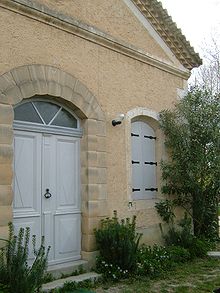- Congénies
-
Congénies
Administration Country France Region Languedoc-Roussillon Department Gard Arrondissement Nîmes Canton Sommières Intercommunality Pays de Sommières Mayor Michel Febrer
(2008–2014)Statistics Elevation 45–145 m (148–476 ft)
(avg. 75 m/246 ft)Land area1 8.64 km2 (3.34 sq mi) Population2 1,542 (2008) - Density 178 /km2 (460 /sq mi) INSEE/Postal code 30091/ 30111 1 French Land Register data, which excludes lakes, ponds, glaciers > 1 km² (0.386 sq mi or 247 acres) and river estuaries. 2 Population without double counting: residents of multiple communes (e.g., students and military personnel) only counted once. Coordinates: 43°46′45″N 4°09′39″E / 43.7791666667°N 4.16083333333°E
Congénies is a commune in the Gard department in southern France.
It is situated between Nîmes, Montpellier, the Cevennes and the Camargue and has a strong Protestant Quaker history. Congénies possesses the only and oldiest purpose-built Quaker Meeting House in France.
Contents
History
Wars of Religion
Le Desert. In 1681, the Catholic King Louis XIV, used his troops to re-convert Protestants. On the 30 June 1685, being Protestant became illegal in Nîmes. The religion moved underground, the paid pastor was replaced by the lay prophet.
La Guerre des Camisards (1702–1711)
Congénies was obliged to provision the troops. On 17 December 1703, Jean Cavalier, a Camisard leader torched the Catholic Church. He was a prophet and took his instructions from God. Thus we see the foundation of a local religious tradition that was principled, rebellious and relied on an ínner spirit, the Inspiré. In 1715, Jean Bénezet of Calvisson was exiled to Holland, and then to London. His son Antoine, made it to Philadelphia. Both joined the Society of Friends.
Quaker connection
Paul Codognan, born in Congénies, walked to London in 1768 and returned on foot to Congénies with Quaker literature. In 1785, the Inspiré made formal contact with the Society of Friends in London.
The Meeting house and Cemetery was built on land purchased from Georges Majolier in 1822. It remained in the ownership of the Societes des Amis, until 1907, when the group was too small to maintain it. This was caused by young men emigrating as they could not accept Military Service, and the young women marrying out of the Society. The Meeting House served as a hospital in the First World War, and was owned in recent years by two English Quaker families and was sold back to the French Friends in 2003. The building has been gutted and is being rebuilt with the interior in the modern style. The exterior is being maintained, and the future of the cemetery is safe.
The name Congénies appears in many Quaker biographies (e.g., that of John Yeardley,) giving evidence of frequent visits.[1] . Congénies possessed also a méthodist chapelle beetween 1869 and 1968.
Population
Historical population of Congénies 1793 1800 1811 1820 1826 1836 1851 1861 1871 1876 719 773 783 939 980 1004 1014 930 915 774 1881 1891 1901 1911 1921 1931 1946 1954 1962 1968 665 687 701 625 578 552 512 525 505 473 1982 1990 1995 1999 2008 596 903 1000 1072 1542 Sights
The gothic catholic church ( XIIème-XVIIème ) with the " Nogaret bell" Put a footnote to explain since 1759 , the Protestant temple built between 1817–1818 , the menhir of Peyra Plantada ( 2500 BC ) and many capitelles in the garrigues ...
Personalities
- Christine Majolier- b. 1805 Congénies, Joined Society of Friends in 1828, died 19 June 1879. Tireless Quaker activist, she often acted as interpreter to other well known Quakers visiting France. As a friend of Mme Rollande, governess to Queen Victoria's children, Christine was often visited by them and invited to meet the Queen. Naturally they spoke French, and in the Quaker manner, Christine wore simple dress addressed her using the tu form, to which the queen took no offence.[1]
- Robert Charleton, visited in the 1821/2 when a child.[2]
- Elizabeth Fry, the prison reformer, visited in 1839 while on a campaigning visit to Nîmes. She celebrated her 60th birthday in the village.
- Henry Newman, a fine watercolourist and from a Quaker family in Leominster, visited Congénies in 1864, and produced an album of watercolours which remain in private hands.
Present
Congénies celebrates its Languedoc heritage with the traditional bull running. Over three days each year there are Abrivados and Bandidos, and bandido de nuit, this occurs over the weekend of the 14th July.
See also
References
- ^ a b Chronique de la vie Quaker française 1750-1938, van Etten, pub SOCIÉTÉ RELIGIEUSE DES AMIS (QUAKERS)12, rue Guy de la Brosse, PARIS (Ve) 1938
- ^ Memoir of Robert Charleton , Compiled Chiefly from his Letters. Edited by his sister in law Anna F. Fox. published Samuel Harris and Co London 1876. Facsimile reprint Kessinger Publishing 2007, ISBN 143268924 X
External links
- Van Etten Book: Congénies et sa vie quaker
- Congénies quaker's house
- A map of Congénies and details of neighbouring communes.
- Association for history of Congénies
Categories:- Communes of Gard
Wikimedia Foundation. 2010.







